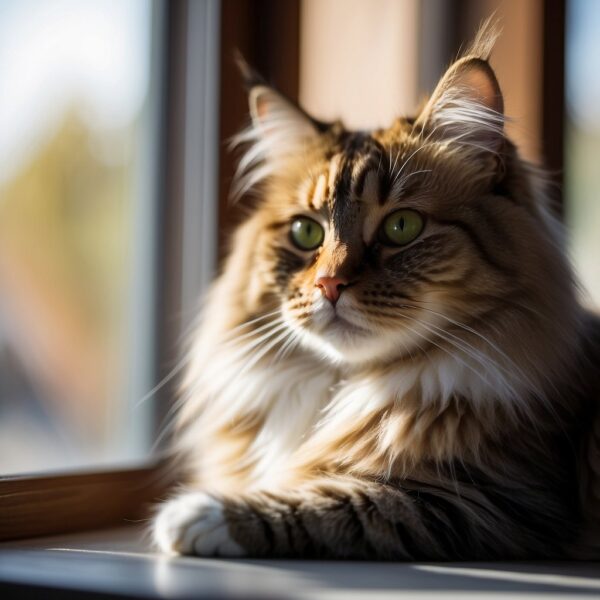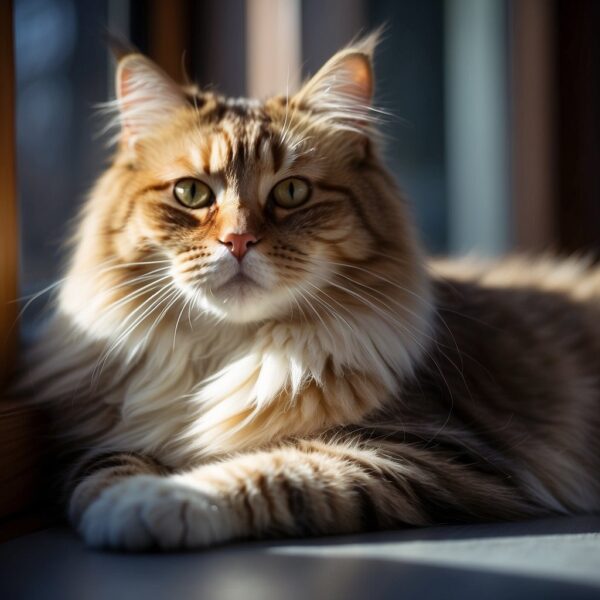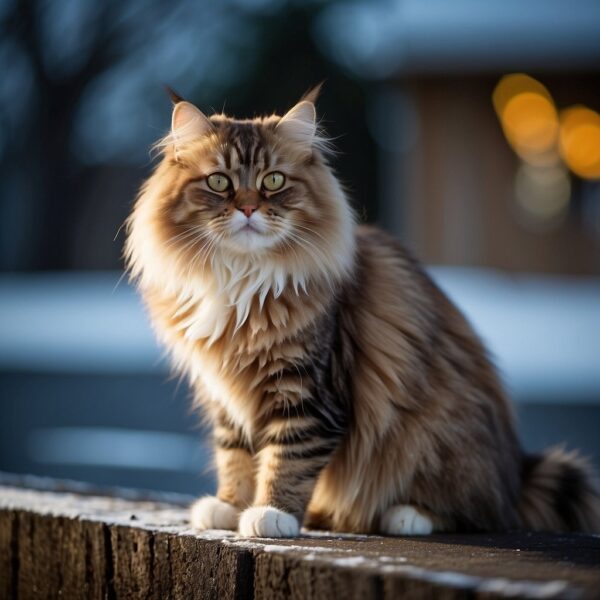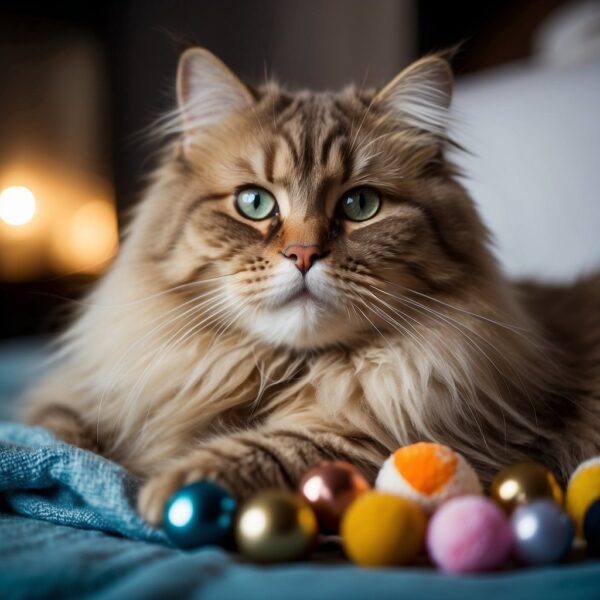
Siberian Cat From Frosty Russian Landscapes
The Siberian cat, hailing from the frosty landscapes of Russia, boasts a rich history that dates back over a thousand years. As a natural breed, they were crafted by the harsh Siberian climate to develop a long, dense triple-layered coat which not only protects them from cold weather but also gives them a majestic appearance. This resilient breed emerged from the dense Siberian forests and is revered for its ability to handle the cold due to its water-resistant fur.
Not just a pretty face, the Siberian cat possesses a warm and engaging personality. They are known to be intelligent, playful, and affectionate companions, which makes them well-suited for families. Their sociable nature means they often get along with other pets and people. Despite their robust build and energetic demeanor, they have a gentle and easygoing temperament that endears them to many.
When it comes to caring for a Siberian cat, prospective parents should be prepared for regular grooming due to their thick coat, and be aware of the potential genetic health issues that can affect the breed. Their love for exploring and playful antics means they’ll thrive in an enriched environment with plenty of stimulation. Understanding the needs and characteristics of the Siberian cat is key to providing them with a happy and healthy life.
Key Takeaways
- The Siberian cat has a luxuriant triple coat adapted to cold climates.
- They are friendly, intelligent, and compatible with families and other pets.
- Siberian cats require regular grooming and benefit from an engaging environment.
History and Origins of Siberian Cats
In examining the Siberian cat’s past, one uncovers a rich tapestry woven through Russia’s history, including the development of its pedigreed status and its rise to prominence in cat shows.
Origins in Russia
The Siberian cat, or Siberian Forest Cat, heralds from Russia, with its presence dating back to around the year 1000 AD. These robust cats are thought to have inhabited the dense forests of Siberia, where their thick, triple-layered coat was essential for survival in harsh climatic conditions. Over the centuries, they became a natural part of Russian folklore and domestic life.
- Region: Russia, specifically Siberia
- Coat: Thick, semi-long triple coat adapted to cold environments
Development of the Siberian Cat Breed
By the 20th century, the Siberian cat caught the attention of the Russian public, leading to the first attempts at formal breeding. It is reported that in the 1970s and 1980s, Russian cat enthusiasts began to establish breeding standards. The Kotofei Cat Club in Leningrad—now known as St. Petersburg—played a key role by creating the breed standard, notably for two Siberian cats: Mars and Roman.
- First breed standard: Established in Leningrad (St. Petersburg)
- Notable cats: Mars (blue and white lynx point) and Roman (white and brown tabby)
Recognition in Cat Shows
The cat’s entrance into formal cat fancy was marked by both Russian and international recognition. Initially, their pedigreed status was recognized within Russian cat clubs. Over time, they caught the eye of cat fanciers worldwide, leading to their participation and recognition in international cat shows.
- Russian recognition: Established pedigree within Russian cat fancier circles
- International recognition: Participation in cat shows outside Russia, gaining global acclaim
Entities:
- Russia: The country of origin for the Siberian cat.
- St. Petersburg and Moscow: Key cities in the development of the Siberian breed standard.
- Siberian and Siberian Forest Cat: Names by which the breed is commonly known.
- Cat Show: Events where the Siberian cat has gained recognition.
- Semi-Longhair: A reference to the Siberian’s coat type.

Breed Characteristics
The Siberian Cat, also known as the Siberian Forest Cat, is a breed renowned for its robust physical form, dense triple-layered coat, and versatile color patterns. Originating from Russia, these cats are equipped for cold climates and exhibit a range of eye colors.
Physical Appearance
Siberian Cats possess a powerful and muscular build, with a broad chest and a rounded, barrel-shaped body that conveys their strength and agility. Their heads are rounded with medium-size ears, and their eyes can be of various colors, often complementing their coat color.
Coat and Color Variations
The most distinctive feature of the Siberian Cat is its long, thick, triple coat that is water-resistant and comprises a full ruff around the neck. The coat varies from coarse to soft and comes in a multitude of colors and patterns, including solids, tabbies, and colorpoints.
Size and Weight
| Gender | Weight Range |
|---|---|
| Male | 15 to 20 pounds |
| Female | 12 to 15 pounds |
Siberian Cats are medium to large in size, with weights that can vary based on gender. They are generally well-proportioned, and their paws are large and round, providing good support for their stout bodies. The balance between their weight and muscular frame is a defining hallmark of the breed.
Personality and Temperament
The Siberian cat exhibits a balance of Playfulness, Intelligence, and social inclination, with a personality that is as lush as its fur. Recognized for their mellow temperament yet energetic demeanor, they are a study in contrasts, combining loyalty and independence in their interactions.
Social Behavior
The felines are known for their Sociable nature, often seeking the companionship of their human families or other pets. They exhibit a friendly temperament that makes them well-suited as family pets.
- Vocality: Siberians are moderately vocal; they will communicate their needs without being overly demanding.
Playfulness and Activity Level
Playfulness is a hallmark of the Siberian cat’s personality. These cats retain a kitten-like level of energy, engaging in play well into their adult years. Their robust and energetic nature means they often enjoy interactive toys and games, showing a penchant for curious exploration of their surroundings.
- Activity Level: High; Siberians stay active and playful throughout their lives.
Intelligence and Trainability
Siberian cats are intelligent and capable of learning a variety of commands and tricks. Their inquisitive nature drives them to explore and figure out puzzles, making them both engaging pets and quick learners. Due to their trainable nature, they respond well to positive reinforcement techniques such as treats or praise during training sessions.
- Problem-Solving: They excel in using their intelligence to navigate their environment and interact with puzzle toys.

Health and Care
When considering the health and care of this breed, one needs to take into account their exercise requirements, grooming needs, and potential health concerns. These are hearty cats with a notable lifespan, but like all cats, they thrive with proper attention to their physical and healthcare needs.
Exercise Needs
Siberian cats possess a high energy level that necessitates regular exercise. They are agile and enjoy climbing, so providing them with cat trees and interactive toys can be beneficial. Engaging in daily play sessions will help satisfy their exercise needs, maintain good health, and strengthen the bond between the cat and its owner.
Grooming Requirements
Grooming is an essential part of this cat’s care. Their luxurious triple coats are less prone to matting than some other long-haired breeds, but they still require regular brushing. It is recommended to brush a Siberian cat at least once a week to control shedding and prevent tangles. Bathing is infrequent, only necessary a few times a year unless the cat gets particularly dirty. These cats produce Fel D1, a common allergen, but are sometimes considered hypoallergenic due to lower allergen levels.
Common Health Issues
Siberian cats can be afflicted with several health issues, like many other breeds. One concern is Hypertrophic Cardiomyopathy (HCM), a common heart condition among cats. Regular veterinary check-ups can spot early signs of HCM and other health problems. Siberians have an average lifespan of 10-18 years, and a well-balanced diet is critical in maintaining their health throughout their lives. Monitoring their weight and providing proper nutrition can help them stay vibrant and healthy for many years.

Living with a Siberian Cat
Living with a Siberian Cat, also known as a Siberian Forest Cat, brings a warm and affectionate presence into your home. These majestic felines adapt well to varied living conditions while being friendly companions to children, other pets, and even strangers. Their fluffy triple coat and moderate activity levels require consistent grooming and exercise.
Adapting to Home Environment
The Siberian Cat usually exhibits a high degree of adaptability to its living environment. Thanks to its origin in the harsh climate of Siberia, this breed has developed a thick triple coat that protects it well against colder climates. However, they also fare well in moderate conditions. Siberian Cats require sufficient mental stimulation and physical exercise to maintain their well-being, and they enjoy spaces where they can climb and explore. As a natural mouser, providing them with toys that satisfy their hunting instincts can be beneficial.
- Climate Adaptability: Siberians are well-equipped for cold climates, but comfortable in moderate ones too.
- Activity Needs: Moderate; ensure room for exercise and climbing.
- Intelligence: Provide toys and activities for mental stimulation.
- Space: Spacious or properly enriched to satisfy their exploratory nature.
Compatibility with Children and Pets
Siberian Cats are known for their affable and friendly demeanor, making them excellent companions for families with children. They exhibit a gentle and patient nature that meshes well with the energetic and sometimes unpredictable behavior of kids. Siberians also tend to get along with other pets, including dogs, particularly if they are introduced to one another at a young age. Their outgoing temperament makes them a perfect addition to a pet-friendly household.
- Good With Children: Yes, patient and playful.
- Good With Dogs and Other Pets: Yes, generally sociable and accepting.
- Consideration for a Second Cat: Well-accepted; Siberians often enjoy the company of another feline.
Considerations for Potential parents
Prospective Siberian Cat owners should consider several aspects before welcoming these pedigreed cats into their homes. Breeders often screen for genetic health issues, but it’s essential to recognize that the breed’s thick, fluffy fur will require regular grooming to manage shedding. Moreover, they are not wholly independent; while they aren’t overly demanding, they do seek affection and may not suit absentee pasrents. Notably, Siberian Cats have been known for being less likely to trigger allergies, a trait attributed to lower levels of the Fel D 1 protein, which can be a deciding factor for those with cat allergies.
- Shedding: High; requires regular grooming.
- Affection: Needs regular interaction.
- Litter Box Training: Siberian kittens typically adapt well to litter box use.
- Health Screening: Consult breeders for potential genetic health considerations.

Frequently Asked Questions
In this section, valuable insights are provided to address common inquiries about Siberian cats, shedding light on cost, family compatibility, grooming, distinct features, allergy considerations, and lifespan.
What factors contribute to the high cost of Siberian cats?
The elevated cost of Siberian cats can be attributed to their purebred status, rarity, and the comprehensive veterinary care they often receive before sale, which may include vaccinations, spaying or neutering, and health screenings.
Are Siberian cats considered good pets for families?
Siberian cats are renowned for their affable nature and strong bonds with family members, making them excellent companions for households that appreciate interactive and affectionate pets.
How much grooming do Siberian cats require?
Despite their moderately long to long triple coats, Siberian cats do not require excessive grooming. A routine involving brushing a few times a week can maintain their coat’s condition and manage shedding.
What distinguishes a Siberian cat from a Maine Coon in terms of characteristics?
Siberian cats typically possess a more rounded physique, with shorter muzzles and slightly forward-tilting ears, as opposed to the Maine Coon’s larger, rectangular body shape and characteristic tufted ears.
Can people with allergies generally tolerate living with a Siberian cat?
Many individuals with allergies find that they can coexist with Siberian cats, possibly due to the breed’s lower levels of the Fel d1 allergen, though this can vary between cats and individuals.
What is the typical lifespan of a Siberian cat?
Siberian cats have a relatively long lifespan, with an average ranging from 10 to 18 years, provided they are given proper care and live in a healthy environment.